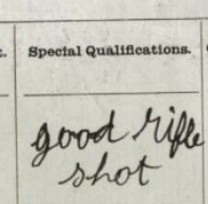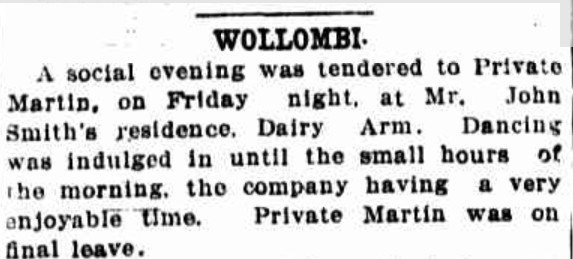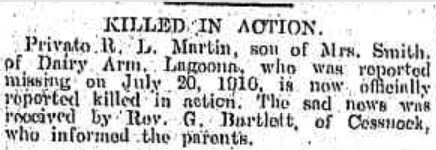Roy Leslie MARTIN
Eyes brown, Hair brown, Complexion sallow
Leslie Roy Martin, known as Roy - “Grenfell, Young, Cobar, Newtown”
Can you help us identify Roy?
Roy was killed in Action at Fromelles. As part of the 30th Battalion he was positioned near where the Germans collected soldiers who were later buried at Pheasant Wood. There is a chance he might be identified, but we need help.
In 2008 a mass grave was found at Fromelles, a grave the Germans dug for 250 (Australian) bodies they recovered after the battle. As of 2024, 180 of these soldiers have been able to be identified via DNA testing. We are still searching for suitable family DNA donors for Roy.
If you know anything of contacts for Roy here in Australia or his relatives from England and Ireland, please contact the Fromelles Association.
See the DNA box at the end of the story for what we do know about his family.
With thanks to Christine Randall for her information about the Martin Ancestors.
Early Life
Leslie Roy Martin (Roy) and his twin sister Sylvia Clarice May were born on 26 May 1896 in Young, New South Wales to John Francis and Mary Jane (nee Nash) Martin. The children were:
- Frank (1892)
- Kathleen (1894)
- Leslie Roy and Sylvia Clarice (twins) (1896)
- Thomas (1898)
- Harold (1901)
- Pearl (1905)
- Arthur (1908).
Roy’s family background is interesting. His grandfather was actually born aboard a convict ship in 1837 and both of his grandmother’s parents came to Australia on a convict ship. His paternal grandparent roots go back to Ardstraw, County Tyrone, Ireland and the maternal side to England. His maternal grandparents were Dublin Irish migrants who settled in Parkes, NSW. Roy’s father worked in the copper mines and the family moved several times in the Central NSW mining and agricultural areas of Grenfell, Young and Cobar, settling in Cobar around 1900.
Roy attended the Cobar Convent school. Around the time when Arthur was born, 1908, Mary went to Newtown, Sydney to a close relative, Mary Anne Theresa Nash. Her school age children would have accompanied her. Roy did report that he spent three years in the Newtown Cadets and he and Frank were living in Newtown when they enlisted. After his schooling, Roy worked as a labourer. The move to Newtown may have reflected marital difficulties.
While Roy’s father stayed in Cobar due to his work, Mary did have to use the courts in 1909 to pursue child support and John and Mary were divorced in 1914. She remarried in 1915 to John Smith and they moved to the Central Coast NSW. Her Nash relatives raised Arthur and he later used that surname. On the brighter side of the family difficulties, all of the children kept in close touch with their mother and she worked with the AIF in following Frank and Roy through their time in the war.
Off to War
Both Roy and his older brother Frank enlisted in 1915, Roy on 15 July and Frank on 22 August (No. 3867) . Roy added a few years to his age to ensure he would be accepted. He also cited his shooting abilities.
Roy was assigned to the newly formed 30th Battalion and Frank to the 2nd Battalion, 12th Reinforcements. The 30th Battalion had been formed on 1 August 1915 at Liverpool, New South Wales. Roy began his military training commenced at the Liverpool camp, but in September they moved to the Royal Agricultural Show Grounds in Moore Park, Sydney. There were numerous reports of their activities in the papers.
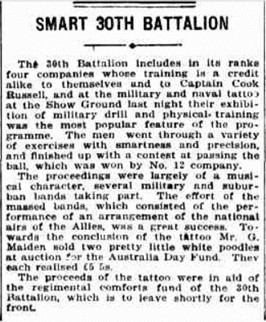

After a short period of military training, Roy left Sydney on 9 November 1915 aboard HMAT A72 Beltana to go to the AIF camps in Egypt. The trip was uneventful and he disembarked on 11 December. Roy’s next seven weeks were spent at the Ferry Post camp guarding the Suez Canal from any potential threats posed by the Ottoman Army and also continuing his training.
In February and March he was at the 40,000 man Tel-el-Kebir camp, 110 km northeast of Cairo. While there, they were inspected by H.R.H. Prince of Wales.
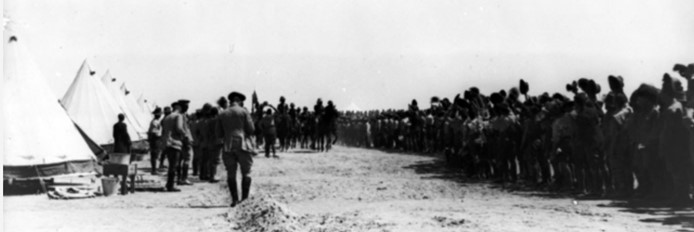
For much of April and May Roy was back at Ferry Post, including some time in the front line trenches there. There were the usual complaints of the heat, water supplies and flies. The call to the Western Front came and on 16 June 1916 the 30th was aboard HMAT Hororata, which arrived in Marseilles on 23 June. After landing, they were immediately entrained for a 60+ hour train ride to Hazebrouck, 30 km from Fleurbaix. They arrived on 29 June and were encamped in Morbecque.
Private F.R. Sharp (2134) wrote home:
“From the time we left Marseilles until we reached our destination was nothing but one long stretch of farms and the scenery was magnificent.” “France is a country worth fighting for.”
The area near Fleurbaix was known as the “Nursery Sector” – a supposedly relatively quiet area where inexperienced Allied troops could learn the harsh realities of Western Front trench warfare against the Germans. But the quiet times did not last long. Training now included the use of gas masks and they also would have heard the heavy artillery from the front lines.
Fromelles
On 8 July they were headed to the front lines, first to Estaires, 20 km and the next day 11 km to Erquinghem, where they were billeted at Jesus Farm. They got their first ‘taste’ of being in the front lines at 9.00 PM on 10 July.
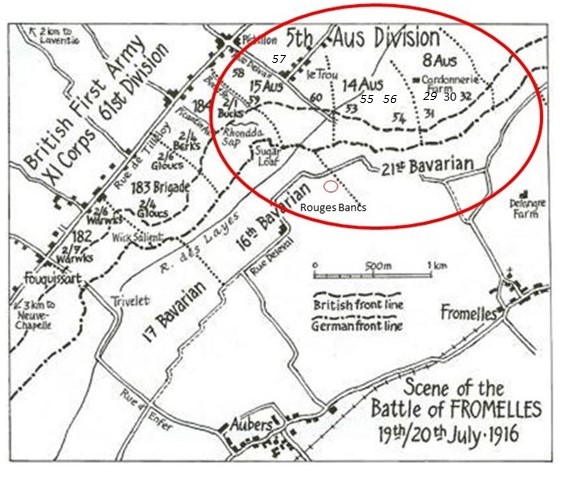
A week later, they got orders for an attack, but it was postponed due to the weather. Then, on 19 July, the 29 officers and 927 other ranks of the 30th Battalion were into battle. The 30th Battalion’s role was to provide support for the attacking 31st and 32nd Battalions by digging trenches and providing carrying parties for supplies and ammunition. They would be called in as reserves if needed for the fighting. The Zero Hour for advancing from their front-line trenches was to be 5.45 PM, but the Germans knew this attack was coming and were well-prepared.
They opened a massive artillery bombardment on the Australians at 5.15 PM, causing chaos and many casualties. The 32nd’s charge over the parapet began at 5.53 PM and the 31st’s at 5.58 PM. There were machine gun emplacements to their left and directly ahead at Delrangre Farm and there was heavy artillery fire in No-Man’s-Land. The initial assaults were successful and by 6.30 PM the Aussies were in control of the German’s 1st line system (Trench B in the diagram below), which was described as “practically a ditch with from 1 to 2 feet of mud and slush at the bottom”.
Source - AWM4 23/49/12, 32nd Battalion War Diaries, July 1916, page 11

Roy’s C Company was initially providing support by carrying supplies, etc, but the commanders on scene made the decision to use the 30th as much-needed fighting reinforcements. A necessary act, but it had consequences as it interfered with the planned flow of supplies.

By 8.30 PM the Australians’ left flank had come under heavy bombardment with high explosives and shrapnel. Return bombardment support was provided and they were told that “the trenches were to be held at all costs”.
Source - AWM4 23/49/12, 32nd Battalion War Diaries, July 1916, page 12
When the 30th was formally called at 10.10 PM to provide fighting support, Lieutenant-Colonel Clark of the 30th reported:
“All my men who have gone forward with ammunition have not returned. I have not even one section left.”
Fighting continued through the night. The Australians made a further charge at the main German line beyond Trench B, but they were low on grenades, there was machine-gun fire from behind from the emplacement at Delangre Farm and they were so far advanced that they were getting shelled by both sides. At 4.00 AM the Germans began an attack from the Australian’s left flank, bombing and advancing into Trench A (map).
Given the Australian advances that had been made earlier, portions of the rear Trench E had been left almost empty, which then enabled the Germans to be in a position to surround the soldiers. At 5.30 AM the Germans attacked from both flanks in force and with bombing parties. Having only a few grenades left, the only resistance the 31st could offer was with rifles:
“The enemy swarmed in and the retirement across No Mans’ Land resembled shambles, the enemy artillery and machine guns doing deadly damage.”
By 10.00 AM on the 20th, the Germans had repelled the Australian attack and the 30th Battalion were pulled out of the trenches. The nature of this battle was summed up by Private Jim Cleworth (784) from the 29th:
"The novelty of being a soldier wore off in about five seconds, it was like a bloody butcher's shop."
Initial figures of the impact of the battle on the 30th were 54 killed, 230 wounded and 68 missing, including Roy. To get some perspective of the battle, when Charles Bean, Australia’s official war historian, attended the battlefield two and half years later, he observed a large quantity of bones, torn uniforms and Australian kit still on the battlefield.
The ultimate total was that 125 soldiers of the 30th Battalion were either killed or died from wounds and of this total 80 were missing/unidentified.
After the Battle
The news that Roy was missing after the battle would have been sent to his mother, but, unfortunately, this was not the first piece of bad news from the war she had received. Roy’s older brother Frank, who had been since reassigned to the 1st Battalion, was actually at Fleurbaix BEFORE Roy arrived.
While working on the trenches at the end of June 1916, Frank was shot in the chest and had to be evacuated to the UK for treatment. He was able to return to his unit in November. We don’t know if Roy was ever aware of this or not.
There are no reliable witness statements about what happened to Roy during the battle. One soldier said that Roy had been wounded and was back in the unit in November, but he then describes Roy as being in his late-30’s and having red hair. Another said he had received a letter from Roy in December 1916. After the battle the Army undertook extensive searches for the missing, there were nothing found about Roy.
On 23 July 1917 Roy was formally declared as having been Killed in Action on 20 July 1916.
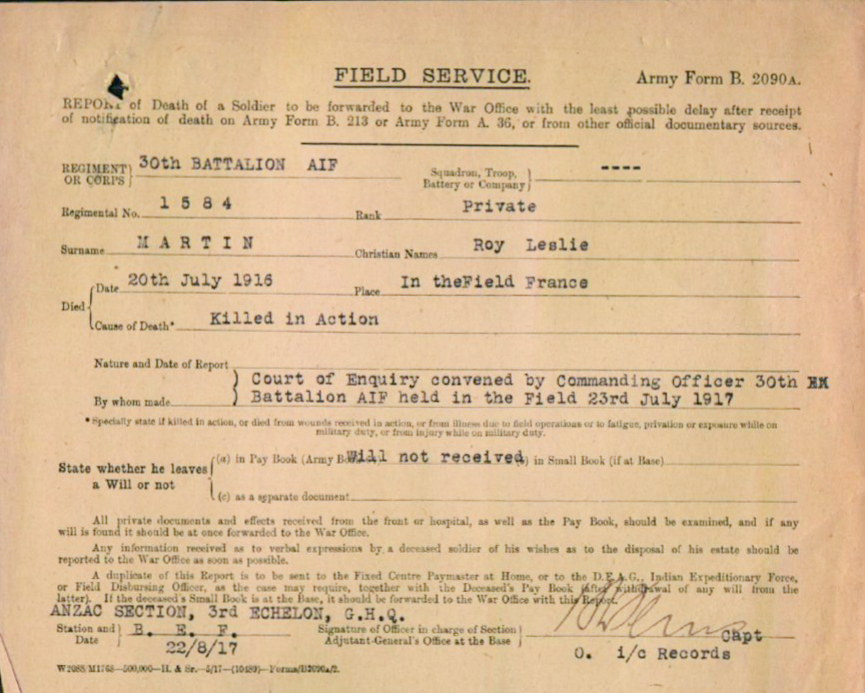
Roy received the 1914-15 Star Medal, the British War Medal, the Victory Medal, a Memorial Plaque and a Memorial Scroll. He is commemorated at V.C. Corner (Panel No 2), Australian Cemetery Memorial, Fromelles, France.
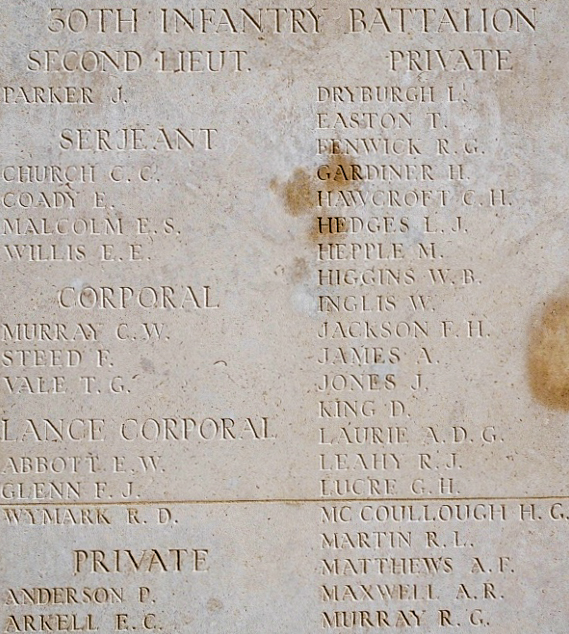
Frank
Frank survived the war, but not without incident. After having been wounded at Fleurbaix, he was shot in his thigh in early May 1917 while at Bullecourt and then in late June he received a severe gunshot wound which fractured his skull while at Lavieville. After treatment in England he was sent back to Australia, embarking on 27 September 1917.
Could Roy Still Be Found?
After the battle, the Germans collected 250 soldiers who were later buried at Pheasant Wood. The 30th was fighting in the vicinity of this grave site and, as of 2024, 26 of the 80 unidentified soldiers from the 30th have been able to be identified by DNA matching from family members. They have been formally recognized in the Pheasant Wood Cemetery. A total of 180 of the 250 soldiers have been identified.
Roy could be one of the remaining 70 unidentified soldiers from the grave, but we are still searching for suitable family DNA donors. If you know anything of Roy’s contacts here in Australia or his relatives from Ireland or England, please contact the Fromelles Association.
DNA samples are being sought for family connections to
| Soldier | Leslie Roy Martin (1896-1916) |
| Parents | John Francis Martin (1869-1920) b Cowra NSW and Mary Jane Cecily Nash (1872-1945) b Grenfell NSW |
| Siblings | John Francis (Frank) (1892-1974) b Grenfell, NSW, m1 Myra Sutton, m2 Gladys Douglas | ||
| Kathleen Ann, (1894-1941) b Young NSW, Nicholas Brown | |||
| Sylvia Clarice May (twin) (1896-1967) b Young, m1 John L Stevens, m2 Peter Rely | |||
| Thomas Joseph Cecil (1898-1957) b Young, NSW | |||
| Harold Raymond (1901-1977) b Cobar, NSW, m Emmaline V Jones | |||
| Pearl Eileen (1905-1974) b Cobar, m William Lyle | |||
| Arthur James Kenneth (1908-1977) b Cobar, RAF WW2 6912, m Eileen Lennon |
| Grandparents | |||
| Paternal | John Francis Martin (1837-1878) b at sea on a convict ship and Catherine Theresa Adelaide Jones ( 1848-1921) | ||
| Maternal | Thomas James Nash (1842-1928) and Ann Mary “Annie” Finn (1841-1885) Grenfell |
Note. The Martins originate from Ardstraw, County Tyrone, Ireland. Catherine Jones’ parents were convicts from Surrey, England. Mary Jane Nash’s grandparents are Dublin Irish migrants who settled in Parkes, NSW.
Seeking DNA Donors

Contacts
(Contact: carla@fromelles.info or geoffrey@fromelles.info).
(Contact: army.uwc@defence.gov.au or phone 1800 019 090).
Donations
If you are able, please contribute to the upkeep of this resource.
(Contact: bill@fromelles.info ).

